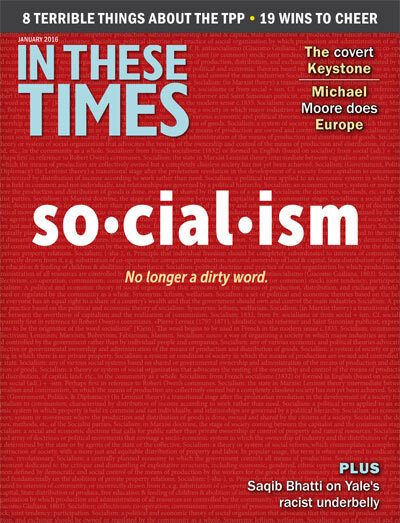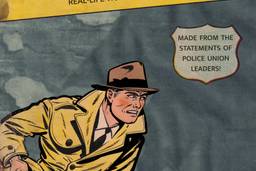Austerity Is Stranger Than Fiction
Filmed in Portugal in 2013 and 2014, Miguel Gomes’ new documentary Arabian Nights tries to make sense of life under IMF rules.
Michael Atkinson

At the outset, Miguel Gomes’ three-part, six-hour epic Arabian Nights, seems to take on the wholesale damage done to Portugal as a result of the austerity imposed by the IMF in 2011. Each of the three chapters begins by declaring that this is not an adaptation of the Arabian Nights per se, but the Scheherazade-spun stories “acquired a fictional form from facts that occurred in Portugal between August 2013 and July 2014.”
“During this period,” the titles continue, “the country was held hostage to a program of economic austerity executed by a government apparently devoid of social justice. As a result, almost all Portuguese became more impoverished.”
Given the chin-out attitude and the project’s formidable length, you’d think you were in for a hellfire screed of the kind Argentine filmmaker Fernando Solanas has been making since the scorching doc The Hour of the Furnaces (1968). But Gomes — whose features Our Beloved Month of August (2008) and Tabu (2012) are elliptical meditations on storytelling, memory and the slippery border between documentary and fiction — is no full-throated radical. He’s more of a whimsical poet, and regardless of his stated scheme, the pain of socioeconomic disaster couldn’t be farther from his agenda. In the beginning of Arabian Nights, Gomes tries to escape his own film crew, running like a fugitive — and then confesses to being in way over his head. (“This is honest,” he told Cinema Scope. “Making this film troubled me.”) It shows: His vast, meandering film is infused with the tension between what Gomes thinks he should do politically and what he simply wants to do as a storyteller.
Viewers of the film (see all three parts or don’t bother) should be prepared for a modernist anti-film, crammed with stories within stories, none of which end properly, and some of which are hard to read as political parables. Gomes’ real fluency is with intimate detail and Renoiresque humanity, which can lead us astray if in fact the project is targeted toward outrage. In the end, the ground staked out turns out to be rather Buñuelian: absurd, unconcerned with narrative propulsion, amused at the antics of the human zoo. The stories that proliferate, framed by a gorgeous Scheherazade (Crista Alfaiate) spinning yarns to keep her Sultan from executing her, are mostly contemporary, fragmented, entangled with documentary reality and sometimes maddening.
The loose fabric begins with ruminations on layoffs at the Viana do Castelo shipyards, and then the relaxed chaos rolls out from there: farcically mer- cenary IMF bankers (on camels and with inspired erections), wizards, talking roosters, ghost dogs, immigrants, suicides, cliff-divers, urine-drenched elevators, haunted apartment blocks, an exploding whale, a heartsick pyromaniac, a plague of bee-killing wasps, a teleporting outlaw fleeing into the mountains, an in-depth exploration of chaffinches and the birdsong-obsessed men who trap them, a criminal trial that implicates everyone present (and uses a cow as a witness) and on and on.
The reality of economic hardship runs through the film like an underground stream, sometimes out of view but always there. Gomes pulled many of the absurd stories (including the outlaw, the pyromaniac and the cock) directly from news headlines, his effort to make sense of a surreal year in his nation’s life.
But here, truth is always happily muddied with invention, even if it’s fantastical title-card exposition layered over passages of genuine en masse street protests. Stories of ordinary Portuguese resorting to petty crime to survive may or may not be true. On the soundtrack, pop music bounces ironically along, from nearly a dozen different versions of “Perfidia,” to the haunting mass chorus of The Langley Schools Music Project’s version of Klaatu’s “Calling Occupants of Interplanetary Craft.”
“Where are stories born?” Scheherazade’s father asks her in Part Three, atop the summer Ferris wheel at Plages du Prado. “They spring from the wishes and fears of man,” she replies.
“And what is their purpose?”
“To help us to survive,” she says, and there’s no clearer way to articulate the storytelling spirit behind Gomes’ film. Its interconnecting tendrils do not reach out to you in an obvious way; repeat viewings, as one film interrupted by time, like Scheherazade’s stories, may be necessary. The thing’s sense of life energy, however, is unmistakable.

I hope you found this article important. Before you leave, I want to ask you to consider supporting our work with a donation. In These Times needs readers like you to help sustain our mission. We don’t depend on—or want—corporate advertising or deep-pocketed billionaires to fund our journalism. We’re supported by you, the reader, so we can focus on covering the issues that matter most to the progressive movement without fear or compromise.
Our work isn’t hidden behind a paywall because of people like you who support our journalism. We want to keep it that way. If you value the work we do and the movements we cover, please consider donating to In These Times.








